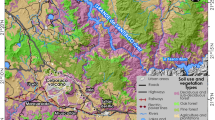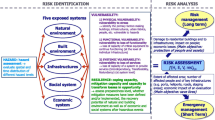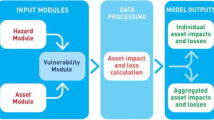Abstract
In a companion paper, a methodology for ranking volcanic hazards and events in terms of risk was presented, and the likelihood and extent of potential hazards in the Auckland Region, New Zealand investigated. In this paper, the effects of each hazard are considered and the risk ranking completed. Values for effect are proportions of total loss and, as with likelihood and extent, are based on order of magnitude.
Two outcomes were considered – building damage and loss of human life. In terms of building damage, tephra produces the highest risk by an order of magnitude, followed by lava flows and base surge. For loss of human life, risk from base surge is highest. The risks from pyroclastic flows and tsunami are an order of magnitude smaller. When combined, tephra fall followed by base surge produces the highest risk. The risks from lava flows and pyroclastic flows are an order of magnitude smaller. For building damage, the risk from Mt. Taranaki volcano, 280 km from the Auckland CBD, is largest, followed by Okataina volcanic centre, an Auckland volcanic field eruption centred on land, then Tongariro volcanic centre. In terms of human loss, the greatest risk is from an Auckland eruption centred on land. The risks from an Auckland eruption centred in the ocean, Okataina volcanic centre, and Taupo volcano are more than an order of magnitude smaller. When combined, the risk from Mt. Taranaki remains highest, followed by an Auckland eruption centred on land. The next largest risks are from the Okataina and Tongariro volcanic centres, followed by Taupo volcano.
Three alternative situations were investigated. As multiple eruptions may occur from the Auckland volcanic field, it was assumed that a local event would involve two eruptions. This increased risk of a local eruption occurring on land so that it was equal to that of an eruption from Mt. Taranaki. It is possible that a future eruption may be of a similar, or larger size, to the previous Rangitoto eruption. Risk was re-calculated for local eruptions based on the extent of hazards from Rangitoto. This increased the risk of lava flow to greater than that of base surge, and the risk from an Auckland land eruption became greatest. The relative probabilities used for Mt. Taranaki volcano and the Auckland volcanic field may only be minimum values. When the probability of these occurring was increased by 50%, there was no change in either ranking.







Similar content being viewed by others
References
Allen SR (1992) Volcanic hazards in the Auckland volcanic field. Unpublished MSc thesis, University of Auckland, Auckland, New Zealand, pp 1–153
Allen SR, Smith IEM (1994) Eruption styles and volcanic hazard in the Auckland volcanic field, New Zealand. Geosci Rep Shizuoka Univ 20:5–14
Auckland Engineering Lifelines Group (2001) Volcanic ash review, Part 1. Auckland Regional Council Technical Publication No 144. Auckland Regional Council, Auckland, New Zealand, pp 1–50
Auckland Regional Council (1999) Auckland engineering lifelines project, final report, stage one. Auckland Regional Council Technical Publication No 112. Auckland Regional Council, Auckland, New Zealand, pp 1–286
Baxter PJ (1990) Medical effects of volcanic eruptions. Bull Volcanol 52:532–544
Baxter PJ (2000) Impacts of eruptions on human health. In: Sigurdsson H, Houghton BF, McNutt SR, Rymer H, Stix J (eds) Encyclopedia of volcanoes. Academic, San Diego, CA, pp 1035–1043
Baxter PJ, Neri A, Todesco M (1998) Physical modelling and human survival in pyroclastic flows. Nat Hazards 17:163–176
Beca Carter & Ferner (2002) Contingency plan for the Auckland volcanic field. Prepared for the Auckland Regional Council, Auckland, New Zealand, pp 1–65
Blong RJ (1984) Volcanic hazards: A sourcebook on the effects of eruptions. Academic, Sydney, Australia, pp 1–424
Blong RJ (2003) Building damage in Rabaul, Papua New Guinea, 1994. Bull Volcanol 65:43–54
Cassidy J, Locke CA, Miller CA, Rout DJ (1999) The Auckland volcanic field, New Zealand: geophysical evidence for its eruption history. In: Firth CR, McGuire WJ (eds) Volcanoes in the Quaternary. Geological Society Special Publication No 161. The Geological Society, London, pp 1–10
Cousins WJ, Heron DW (2001) An assets model for New Zealand buildings for use in risk studies. Institute of Geological and Nuclear Sciences 2001/3, Lower Hutt, New Zealand, pp 1–19
Johnston DM, Nairn IA, Thordarson T, Daly M (1997) Volcanic impact assessment for the Auckland volcanic field. Auckland Regional Council, Auckland, New Zealand, pp 1–208
Johnston DM, Houghton BF, Neall VE, Ronan KR, Paton D (2000) Impacts of the 1945 and 1995–1996 Ruapehu eruptions, New Zealand: An example of increasing societal vulnerability. Geol Soc Am Bull 112:720–726
Magill CR, Blong RJ (2004) Volcanic risk ranking for Auckland, New Zealand. I: Methodology and hazard investigation (this volume)
Mrozek JR, Taylor LO (2002) What determines the value of life? A meta-analysis. J Policy Anal Manag 21:253–270
Paton D, Johnston DM, Gough J, Dowrick D, Manville V, Daly M, Batistich T, Baddon L (1999) Auckland volcanic risk project: Stage 2. Auckland Regional Council, Auckland, New Zealand, pp 1–99
Peterson DW, Tilling RI (2000) Lava flow hazards. In: Sigurdsson H, Houghton BF, McNutt SR, Rymer H, Stix J (eds) Encyclopedia of volcanoes. Academic, San Diego, CA, pp 957–971
Pomonis A, Spence RJS, Baxter PJ (1999) Risk assessment of residential buildings for an eruption of Furnas Volcano, São Miguel, The Azores. J Volcanol Geoth Res 92:107–131
Rout DJ, Cassidy J, Locke CA, Smith IEM (1993) Geophysical evidence for temporal and structural relationships within the monogenetic basalt volcanoes of the Auckland volcanic field, northern New Zealand. J Volcanol Geoth Res 57:71–83
Sadler JP, Grattan JP (1999) Volcanoes as agents of past environmental change. Global Planet Change 21:181–196
Sandiford A, Alloway BV, Shane P (2001) A 28 000–6600 cal yr record of local and distal volcanism preserved in a paleolake, Auckland, New Zealand. New Zeal J Geol Geop 44:323–336
Self S, Rampino MR, Barbera JJ (1981) The possible effects of large 19th and 20th century volcanic eruptions on zonal and hemispheric surface temperatures. J Volcanol Geoth Res 11:41–60
Shane P, Hoverd J (2002) Distal record of multi-sourced tephra in Onepoto Basin, Auckland, New Zealand: implications for volcanic chronology, frequency and hazards. Bull Volcanol 64:441–454
Spence RJS, Pomonis A, Baxter PJ, Coburn AW, White M, Dayrit M, Field Epidemiology Training Program Team (1996) Building damage caused by the Mount Pinatubo eruption of June 15, 1991. In: Newhall CG, Punongbayan RS (eds) Fire and mud: eruptions and lahars of Mount Pinatubo, Philippines. Philippine Institute of Volcanology and Seismology, University of Washington Press, Seattle, WA, pp 1055–1061
Tanguy J-C, Ribière C, Scarth A, Tjetjep WS (1998) Victims from volcanic eruptions: a revised database. Bull Volcanol 60:137–144
Acknowledgements
We would like to thank Professor John McAneney and Dr. Keping Chen for helpful reviews of an early draft, and Dr. Ian Smith for valuable discussions. The manuscript has benefited from reviews and advice from Dr. David Johnston, Dr. Steve Oldfield, and an anonymous referee. Risk Frontiers is grateful for the strong support of a number of sponsors in the insurance industry. This work was completed while Christina Magill was holding a Macquarie University Research Award for Areas and Centres of Excellence (RAACE).
Author information
Authors and Affiliations
Corresponding author
Additional information
Editorial responsibility: J. S. Gilbert
Rights and permissions
About this article
Cite this article
Magill, C., Blong, R. Volcanic risk ranking for Auckland, New Zealand. II: Hazard consequences and risk calculation. Bull Volcanol 67, 340–349 (2005). https://doi.org/10.1007/s00445-004-0375-5
Received:
Accepted:
Published:
Issue Date:
DOI: https://doi.org/10.1007/s00445-004-0375-5




